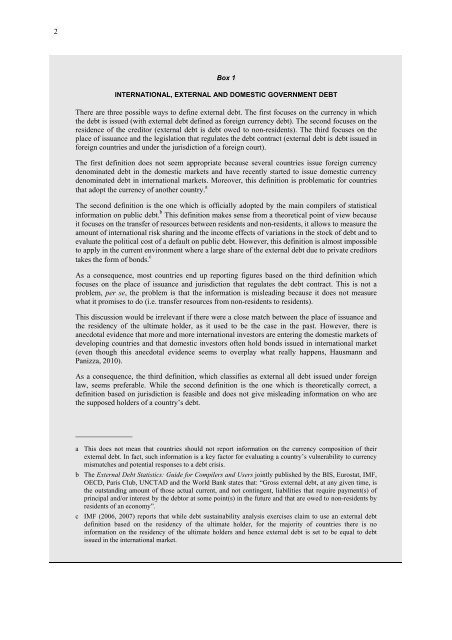International government debt - UNCTAD Discussion Paper No. 199
International government debt - UNCTAD Discussion Paper No. 199
International government debt - UNCTAD Discussion Paper No. 199
You also want an ePaper? Increase the reach of your titles
YUMPU automatically turns print PDFs into web optimized ePapers that Google loves.
2<br />
Box 1<br />
INTERNATIONAL, EXTERNAL AND DOMESTIC GOVERNMENT DEBT<br />
There are three possible ways to define external <strong>debt</strong>. The first focuses on the currency in which<br />
the <strong>debt</strong> is issued (with external <strong>debt</strong> defined as foreign currency <strong>debt</strong>). The second focuses on the<br />
residence of the creditor (external <strong>debt</strong> is <strong>debt</strong> owed to non-residents). The third focuses on the<br />
place of issuance and the legislation that regulates the <strong>debt</strong> contract (external <strong>debt</strong> is <strong>debt</strong> issued in<br />
foreign countries and under the jurisdiction of a foreign court).<br />
The first definition does not seem appropriate because several countries issue foreign currency<br />
denominated <strong>debt</strong> in the domestic markets and have recently started to issue domestic currency<br />
denominated <strong>debt</strong> in international markets. Moreover, this definition is problematic for countries<br />
that adopt the currency of another country. a<br />
The second definition is the one which is officially adopted by the main compilers of statistical<br />
information on public <strong>debt</strong>. b This definition makes sense from a theoretical point of view because<br />
it focuses on the transfer of resources between residents and non-residents, it allows to measure the<br />
amount of international risk sharing and the income effects of variations in the stock of <strong>debt</strong> and to<br />
evaluate the political cost of a default on public <strong>debt</strong>. However, this definition is almost impossible<br />
to apply in the current environment where a large share of the external <strong>debt</strong> due to private creditors<br />
takes the form of bonds. c<br />
As a consequence, most countries end up reporting figures based on the third definition which<br />
focuses on the place of issuance and jurisdiction that regulates the <strong>debt</strong> contract. This is not a<br />
problem, per se, the problem is that the information is misleading because it does not measure<br />
what it promises to do (i.e. transfer resources from non-residents to residents).<br />
This discussion would be irrelevant if there were a close match between the place of issuance and<br />
the residency of the ultimate holder, as it used to be the case in the past. However, there is<br />
anecdotal evidence that more and more international investors are entering the domestic markets of<br />
developing countries and that domestic investors often hold bonds issued in international market<br />
(even though this anecdotal evidence seems to overplay what really happens, Hausmann and<br />
Panizza, 2010).<br />
As a consequence, the third definition, which classifies as external all <strong>debt</strong> issued under foreign<br />
law, seems preferable. While the second definition is the one which is theoretically correct, a<br />
definition based on jurisdiction is feasible and does not give misleading information on who are<br />
the supposed holders of a country’s <strong>debt</strong>.<br />
_______________<br />
a This does not mean that countries should not report information on the currency composition of their<br />
external <strong>debt</strong>. In fact, such information is a key factor for evaluating a country’s vulnerability to currency<br />
mismatches and potential responses to a <strong>debt</strong> crisis.<br />
b The External Debt Statistics: Guide for Compilers and Users jointly published by the BIS, Eurostat, IMF,<br />
OECD, Paris Club, <strong>UNCTAD</strong> and the World Bank states that: “Gross external <strong>debt</strong>, at any given time, is<br />
the outstanding amount of those actual current, and not contingent, liabilities that require payment(s) of<br />
principal and/or interest by the <strong>debt</strong>or at some point(s) in the future and that are owed to non-residents by<br />
residents of an economy”.<br />
c IMF (2006, 2007) reports that while <strong>debt</strong> sustainability analysis exercises claim to use an external <strong>debt</strong><br />
definition based on the residency of the ultimate holder, for the majority of countries there is no<br />
information on the residency of the ultimate holders and hence external <strong>debt</strong> is set to be equal to <strong>debt</strong><br />
issued in the international market.

















